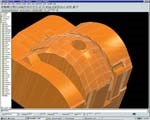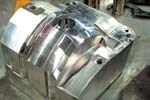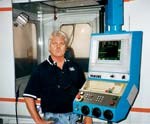Prescription For Success
For an Ontario mold shop, higher cutting speeds meet the challenge of producing optical-quality surfaces.
Share




Among the myriad features that manufacturers specify for plastic injection molds, optical qualities are rarely included as design factors. But in the automotive world, the appearance of headlights and taillights is a critical aspect of styling and safety. For this reason, a mold shop that specializes in tooling for automotive lighting faces the additional hurdle of machining surfaces that are judged on the basis of how effectively they transmit light.
Meeting these unusual requirements is the stock-in-trade of Platinum Tool Technologies Inc., Oldcastle, Ontario. The shop was established in 1999 as a partnership of four men with extensive experience in the metalworking industry. The management team includes Scott Dell (Design and Estimating), Randy Soulliere (Manufacturing Manager), Dan Moynahan (Business/Financial Officer) and Nick Buchok (Machining Manager).
Specializing exclusively in building molds for optical applications, this 2-year-old shop has experienced strong growth on the wings of its customers' continual styling refinements. Because the multi-faceted surfaces inside headlight assemblies must be mirror-smooth to properly reflect and direct light, Platinum Tool's machining process must be capable of finishing the corresponding mold-cavity components to extremely tight tolerances (Figure 1, below right).
At this level of surface quality, neither hand finishing nor EDM represents a desirable option. Automotive clients require tooling with the durability to produce a huge quantity of parts without degradation of their complex reflective surfaces. Because automobile lights are designed to deliver precise optical performance that must conform to strict government regulations, each product incorporates a unique prescription to satisfy these requirements. This is particularly true in the case of modern headlights, many of which are designed to direct the lamp's beam backwards onto reflective surfaces.
Extremely hard steels such as H13 stainless (52 Rc) are specified to create molds for these parts. To finish these metals without bench work, the machining process must remove excess stock in very tiny increments or stepovers. For Platinum Tool, high speed machining has become the one and only solution to this substantial challenge.
Hands-On Quality Control
Machining Manager Nick Buchok is a strong proponent of shopfloor programming. He has used this strategy for approximately 5 years, and it has been part of Platinum Tool's daily operations since the shop opened for business. As a machinist with 22 years' experience, Mr. Buchok believes that the benefits of training machine operators to be proficient programmers are self-evident.
"How does a programmer sitting in an office know what type of workholding is being used or what specific cutting conditions the operator will face?" he asks. In the past, Mr. Buchok recalls that, when a problem occurred during a machining cycle, the operator was forced to shut down the machine and go back to the programmer for a solution. At Platinum Tool, these programming corrections are made in a few minutes without the operator leaving the machine or delaying production.
Another advantage of programming at the machine is the intimate connection that the operator has to workflow issues. Although this work is much more demanding than simply running programs created by others, it's also more rewarding in terms of the pride and satisfaction that operators derive from putting their own machining strategies into action (Figure 2, below right). Still, however, Mr. Buchok admits this scheme isn't for everyone. "Many companies can't make it work because operators must be willing to do three or four jobs at the same time, as well as being able to schedule them properly, to increase the amount of work completed in a day," he says.
In terms of Platinum Tool's daily schedule, this often means that Mr. Buchok programs additional finish machining cycles during his daytime shift—then runs them during night shifts (unattended except for tool changes and occasional sharpening). This strategy enables a shop's most experienced programmers to set the stage for other operators who may still be developing their programming skills.
Considering that initiating a high speed process adds substantially to a shop's programming workload, the advantages of shopfloor programming become even more pronounced in this environment. Also, because continual experimentation is central to the development of an efficient, high speed process, shopfloor programming can help to develop this creativity.
For his own work, Mr. Buchok programs in NURBS (non-uniform, rational B-spline machining) using PowerMILL CAM software (Delcam International Inc., Windsor, Ontario, Canada). In Platinum Tool's particular applications, NURBS programs provide faster and more precise tool control than conventional point-to-point programming. The Selca controller from Selca Inc. (Grand Rapids, Michigan) on Mr. Buchok's high speed machining center provides on-the-fly conversion of point-to-point programs to NURBS.
Some machine shop managers have resisted shopfloor programming because of legitimate fears that their operators are not adequately trained to assume these duties. Based on his background as a machinist who formerly made the jump from the shop to the office, however, Mr. Buchok believes that another factor is also responsible for resistance to change. Because the majority of office-based programmers began their careers as machinists, he believes that some feel threatened by the prospect of returning to the shop floor. Thus, the original specialization and physical separation of machine programming and operating tasks may have created the impression that programming in the shop represents diminished status. But for reasons of practicality and efficiency, Mr. Buchok believes that the shop floor is precisely where programmers belong.
This explains why Mr. Buchok is a hands-on manager who intends to keep Platinum Tool's rapid growth under control. The shop currently has 28 employees running two shifts per day. The management team believes that 50 employees is the maximum number that could be effectively managed while maintaining the shop's quality standards.
To succeed with this strategy requires a very high level of training and personal commitment. It also requires people who are intrigued by the prospect of experimenting with alternative tooling and techniques in the course of their daily work. "One of the most important benefits is the opportunity it provides to perfect new techniques in high speed machining," says Mr. Buchok.
In The Cutting Zone
High speed machining succeeds because of many advantages inherent to its method of metal removal. A key advantage of this technique is the ability to perform high precision hard milling more rapidly with minimal tool wear. When machining the cavity surfaces of mold inserts that reproduce the reflective areas of finished parts, Mr. Buchok adds an additional step to his process for machining other cavity surfaces. First, he roughs the insert so that 0.050 inch of stock remains. Then, the soft steel (35 Rc) undergoes stress relief and hardening. Next, a semi-finishing cycle machines the insert down to 0.015 inch of remaining stock. For reflective cavity surfaces, the insert is then pre-finished down to 0.005 inch of stock. Finally, the finishing cycle machines the insert surfaces very close to their ideal dimensions.
But how close is "close?" According to Mr. Buchok, the completed surfaces are so smooth that, when metalized coatings are applied to the finished parts' plastic surfaces by his customer, all evidence of machining disappears. "Both a beautifully smooth finish and excellent accuracy can be achieved by reducing the amount of stock remaining prior to finishing, as well as by using a very fine stepover," says Mr. Buchok. Indeed, the principal purpose of using a high speed process is to achieve greater accuracy by eliminating hand-working.
A combination of high spindle speed, high feed rate and minimal cutting depth allows cutting tools to perform with very little heat or deflection, and without persistent breakage. Typically, Mr. Buchok's high speed cutting tools generate so little heat during finishing cycles that he can safely handle them immediately afterwards.
At spindle speeds that exceed 20,000 rpm, the margin between efficient and inefficient hard milling is quite narrow. For example, during one machining cycle for the reflective surfaces on a pair of mold inserts, Mr. Buchok programmed his Takumi B8 Model Bridge Mill from Takumi Seiki (Santa Fe Springs, California) to make 0.002-inch-deep stepover cuts at the machine's maximum spindle speed of 22,000 rpm—with a feed rate as high as 600 ipm (Figure 3, at left). If this same cycle were run using a 0.004-inch cutting depth, tool consumption would be excessive. Thus, developing an efficient high speed process consists of substantial experimentation to determine the proper cutters, speeds, feeds and cutting depths for various workpiece materials. These subtle refinements constitute the competitive secrets of a successful machining process.
All of Mr. Buchok's high speed work involves climb milling, and the majority of cutting tools that he uses for finishing work are multi-fluted, flat-bottom end mills. Describing his machining process for the reflective areas on mold-cavity inserts, Mr. Buchok says, "We start our semi-finishing with a 1.250-inch diameter button cutter and work our way down to a 0.125-inch tool." To finish fine details on the inserts' reflective areas, his customer specifies the use of an 0.040-inch diameter (1 mil) ball-nose tool.
A key aspect of Mr. Buchok's machining process involves the type of toolpath sequence that he chooses for finishing the inserts' reflective surfaces. Instead of keeping the cutting tool in constant contact with the metal, Mr. Buchok finds that making successive cutting strokes in the same direction produces a smoother finish. In this cutting sequence, the tool is removed from the metal at the end of each stoke—then returns to the beginning of the next stepover cut. Although this method involves some extra time during which the tool is not cutting, the machine's 1,200-ipm rapid traverse speed and acceleration minimize this factor.
Because this hard milling process is based on taking light cuts at higher speeds and feed rates, cutting tools are not designed to withstand sudden collisions. "You never want to unexpectedly hit stock when you're machining at high speeds," Mr. Buchok warns. To curtail this problem, he uses slightly larger diameter tools for finish machining than the tools he uses to semi-finish the insert surfaces. This eliminates the possibility that a finishing tool will fracture or perhaps damage a workpiece as the result of hitting stock at the bottom of the previous cut. Maintaining a uniform cutting load at high speeds also requires more extensive programming and more careful tool selection. But for Platinum Tool, this extra effort pays big dividends.
The shop uses shrink-fit toolholders exclusively for its high speed machines. Because shrink-fit toolholders have slimmer profiles than those incorporating setscrews or collets (Figure 4, above right), they're well suited for negotiating tight clearances during hard milling work. In high speed applications, shrink-fit toolholders also provide secure gripping of cutting tools.
Toward A Faster Future
Platinum Tool's commitment to more rapid and precise production is reflected by its recent purchase and pending delivery of a gantry-type high speed machining center from Breton Company, Castello di Godego, Italy (Figure 5, at right). This machine moves the tool in all three axes and its table is fixed. This eliminates the weight of the workpiece as an operational factor and provides a more stable cut. The machine also has a maximum feed rate of 2,685 ipm. With the addition of this machine, Mr. Buchok looks forward to improving the efficiency of his process even more.
Beyond the process itself, high speed machining differs from conventional machining because no handy reference guides are available to provide reliable parameters for machining various materials. Perfecting a high speed process depends on a continuous series of closely monitored trials, many of which are conducted in the course of regular production cycles. In this regard, shops that have already taken the high speed route are writing their own books every day.
Platinum Tool's success in writing its book is illustrated by the fact that this shop continues to flourish in the very competitive Detroit/Windsor region despite less than ideal market conditions in the automobile industry. Meeting its challenge head on, Platinum Tool continues to invest substantial resources in the equipment and skilled workforce necessary to ensure its present and future prosperity.
Related Content
How to Accelerate Robotic Deburring & Automated Material Removal
Pairing automation with air-driven motors that push cutting tool speeds up to 65,000 RPM with no duty cycle can dramatically improve throughput and improve finishing.
Read MoreRead Next
5 Rules of Thumb for Buying CNC Machine Tools
Use these tips to carefully plan your machine tool purchases and to avoid regretting your decision later.
Read MoreBuilding Out a Foundation for Student Machinists
Autodesk and Haas have teamed up to produce an introductory course for students that covers the basics of CAD, CAM and CNC while providing them with a portfolio part.
Read MoreRegistration Now Open for the Precision Machining Technology Show (PMTS) 2025
The precision machining industry’s premier event returns to Cleveland, OH, April 1-3.
Read More



































